
A skeleton knife refers to two different types of knives, a kitchen knife and an unadorned penknife. [1]

A skeleton knife refers to two different types of knives, a kitchen knife and an unadorned penknife. [1]
The first type of skeleton knife is a small kitchen knife that typically has three large holes on its blade used for cutting fruit or cheese. The purpose of these holes is to reduce the surface area of the blade so that sticky foods do not cling to it. Most skeleton knives are used for cutting very soft foods.
The knife was created by a Swiss restaurant and after its creation and advertisement it was stolen by many cutlery companies and private manufacturers, and is now widely manufactured by companies like Victorinox. [2]
The less commonly known type of skeleton knife is a penknife that was made without bolsters or handle material and sold to jewelers or other artisans for final finishing. [1]
These types of knives were mostly made in the 19th century and as late as 1950. Wostenholm of Sheffield, England made many of these knives as did Imperial Knife Co. in the United States. Jewelers would finish the knives' handles in semi precious stones and in some cases gold or other precious metals in their own style. [1]

A utility knife or Stanley knife is a knife used for general or utility purposes. The utility knife was originally a fixed blade knife with a cutting edge suitable for general work such as cutting hides and cordage, scraping hides, butchering animals, cleaning fish, and other tasks. Craft knives are tools mostly used for crafts. Today, the term "utility knife" also includes small folding or retractable-blade knives suited for use in the general workplace or in the construction industry.

A knife is a tool with a cutting edge or blade often attached to a handle or hilt. One of the earliest tools used by mankind, knives appeared at least two-and-a-half million years ago, as evidenced by the Oldowan tools. Originally made of wood, bone, and stone, over the centuries, in step with improvements in both metallurgy and manufacturing, knife blades have been made from copper, bronze, iron, steel, ceramic, and titanium. Most modern knives have either fixed or folding blades; blade patterns and styles vary by maker and country of origin.
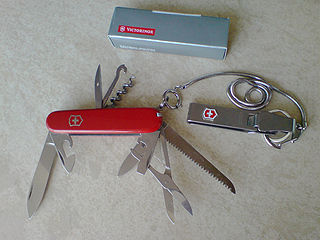
The Swiss Army knife is a pocketknife or multi-tool manufactured by Victorinox. The term "Swiss Army knife" was coined by American soldiers after World War II due to the difficulty they had in pronouncing "Offiziersmesser", the German name.
A blade is the portion of a tool, weapon, or machine with an edge that is designed to puncture, chop, slice or scrape surfaces or materials. Blades are typically made from materials that are harder than those they are to be used on. Historically, humans have made blades from flaking stones such as flint or obsidian, and from various metal such as copper, bronze and iron. Modern blades are often made of steel or ceramic. Blades are one of humanity's oldest tools, and continue to be used for combat, food preparation, and other purposes.

Japanese kitchen knives are a type of a knife used for food preparation. These knives come in many different varieties and are often made using traditional Japanese blacksmithing techniques. They can be made from stainless steel, or hagane, which is the same kind of steel used to make Japanese swords. Most knives are referred to as hōchō or the variation -bōchō in compound words, but can have other names including -kiri. There are four general categories used to distinguish the Japanese knife designs: handle, blade grind, steel, and construction.

A blade's grind is its cross-sectional shape in a plane normal to the edge. Grind differs from blade profile, which is the blade's cross-sectional shape in the plane containing the blade's edge and the centre contour of the blade's back. The grind of a blade should not be confused with the bevel forming the sharpened edge; it more usually describes the overall cross-section of the blade, not inclusive of the beveled cutting edge which is typically of a different, less acute angle as the bevel ground onto the blade to give it a cross-sectional shape. For example, the famous Buck 110 hunting knife has a "hollow ground" blade, with concave blade faces, but the cutting edge itself is a simple, flat-ground bevel of lesser angle. It would be difficult, if not impossible, to put a "hollow grind" onto the actual cutting edge of the blade itself, which is a very narrow and small bevel.
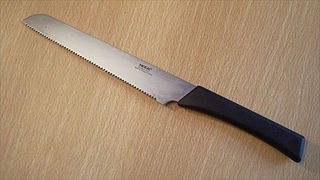
Bread knives are used for cutting bread and are one of many kitchen knives used by cooks. The serrated blades of bread knives are able to cut soft bread without crushing it.
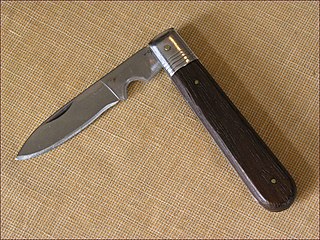
A penknife, or pen knife, is a British English term for a small folding knife. Today the word penknife is the common British English term for both a pocketknife, which can have single or multiple blades, and for multi-tools, with additional tools incorporated into the design.
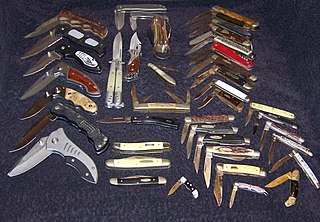
A pocketknife is a foldable knife with one or more blades that fit inside the handle that can still fit in a pocket. It is also known as a jackknife (jack-knife) or a penknife, though a penknife may also be a specific kind of pocketknife. A typical blade length is 5 to 15 centimetres. Pocketknives are versatile tools, and may be used for anything from opening an envelope, to cutting twine, slicing a piece of fruit or even as a means of self-defense.

A kitchen knife is any knife that is intended to be used in food preparation. While much of this work can be accomplished with a few general-purpose knives – notably a large chef's knife, a tough cleaver, and a small paring knife – there are also many specialized knives that are designed for specific tasks. Kitchen knives can be made from several different materials.
In cooking, a chef's knife, also known as a cook's knife, is a cutting tool used in food preparation. The chef's knife was originally designed primarily to slice and disjoint large cuts of beef. Today it is the primary general-utility knife for most western cooks.

The Santoku bōchō or Bunka bōchō (文化包丁) is a general-purpose kitchen knife originating in Japan. Its blade is typically between 13 and 20 cm long, and has a flat edge and a sheepsfoot blade that curves down an angle approaching 60 degrees at the point. The term Santoku may refer to the wide variety of ingredients that the knife can handle: meat, fish and vegetables, or to the tasks it can perform: slicing, chopping and dicing, either interpretation indicating a multi-use, general-purpose kitchen knife. The Santoku's blade and handle are designed to work in harmony by matching the blade's width and weight to the weight of the tang and the handle.
Wüsthof is a knife-maker based in Solingen, Germany. Family owned for seven generations, the company's main products are mid-priced to high-end kitchen knives for domestic and professional use. Wüsthof is one of the leading manufacturers of chef's knives.
Spyderco is an American cutlery company based in Golden, Colorado, U.S.A., producing knives and knife sharpeners. Spyderco pioneered many features that are now common in folding knives, including the pocket clip, serrations, and the opening hole. Spyderco has collaborated with 30 custom knife makers, athletes, and self-defense instructors for designs and innovated the usage of 20 different blade materials.
A boning knife is a type of kitchen knife with a sharp point and a narrow blade. It is used in food preparation for removing the bones of poultry, meat, and fish. Generally 12 cm to 17 cm in length, it features a very narrow blade. Boning knives are not as thick-bladed as some of other popular kitchen or butcher knives, as this makes precision boning, especially deep cuts and holes easier. A stiff boning knife is good for boning beef and pork, but a very flexible boning knife is preferred for poultry and fish.

Knife sharpening is the process of making a knife or similar tool sharp by grinding against a hard, rough surface, typically a stone, or a flexible surface with hard particles, such as sandpaper. Additionally, a leather razor strop, or strop, is often used to straighten and polish an edge.

A cheese knife is a type of kitchen knife specialized for the cutting of cheese. Different cheeses require different knives, according primarily to hardness; most often "cheese knife" refers to a knife designed for soft cheese.

A grapefruit knife is a special type of knife designed specifically for cutting grapefruit. Grapefruit knives are small with a curved serrated blade, designed to hug the curves of the grapefruit. This is used to separate the outer edge of the segments from the rim of the fruit. The term "grapefruit knife" can refer to a type of knife with short, serrated twin blades about 2mm apart, used to separate the sides of each section from the dividing membrane. Some grapefruit knives incorporate both types, a double-sided curved blade on one side and the parallel twin blades on the other. Another type includes an angled tip and double sided serrated blade. When both types are used, the result is an intact-looking fruit with sections which lift out easily - especially if a "grapefruit spoon" is used.

A fillet knife is a kitchen knife used for filleting. It gives good control and aids in filleting. It is a very flexible member of the boning knife family that is used to filet and prepare fish. Fillet knife blades are typically 15 to 28 cm long. This allows them to move easily along the backbone and under the skin of meat.
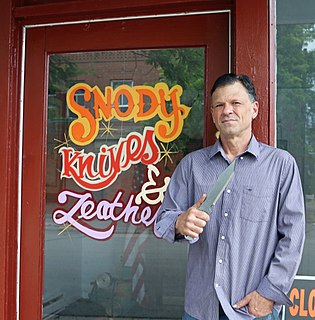
Mike Snody is a Southern Texas knife maker who is known for his use of exotic materials in his custom knives. He is currently based in Walsenburg, Colorado.